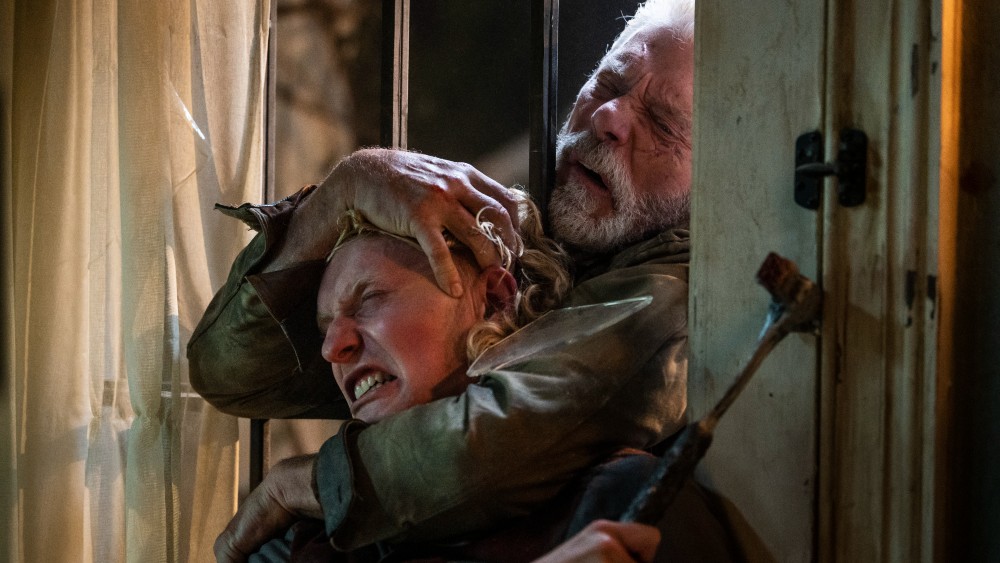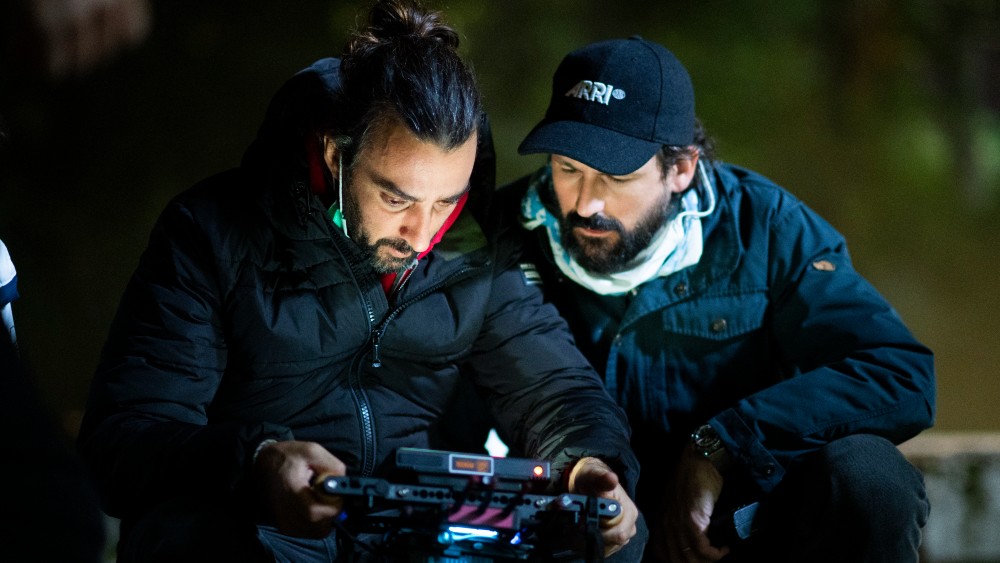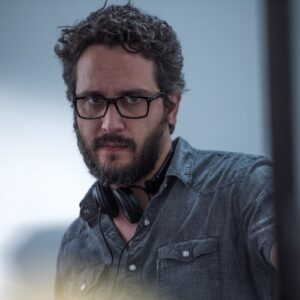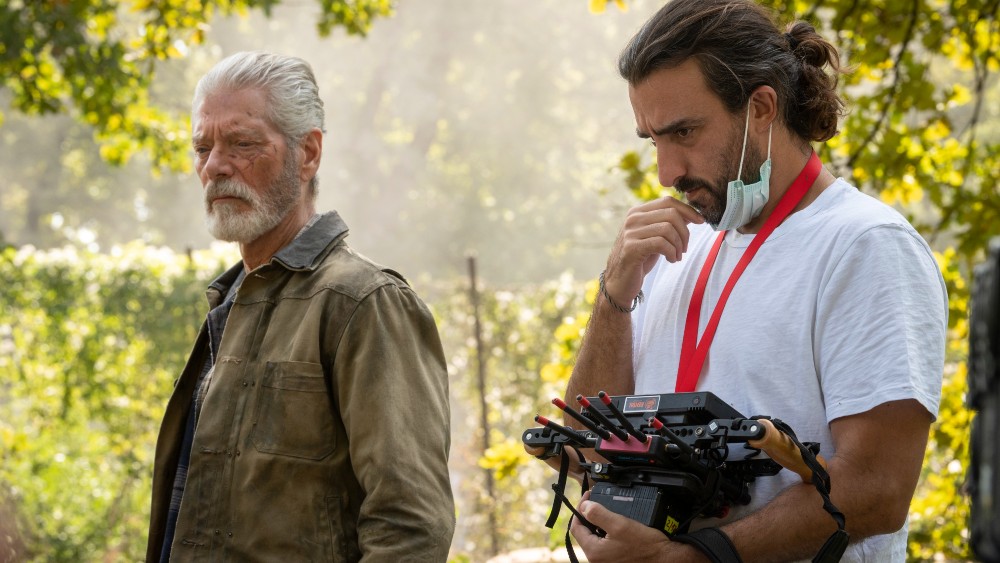
In 2016, director Fede Alvarez, who had previously worked with original director Sam Raimi to reinvent Evil Dead, directed an original R-rated horror movie called Don’t Breathe, about a group of young Detroit criminals who sneak into the home of a blind man (Stephen Lang) with the intentions to steal a fortune of money, not realizing that even blind, he could fight them off and kill them.
Rodo Sayagues co-wrote and co-produced Don’t Breathe, and now, he’s become the director for Don’t Breathe 2, which follows the story of Lang’s character as he’s now living with his daughter Phoenix (Madelyn Grace) when a group of men invade the home with a secret and bad intentions. Lang’s Blind Man now has to protect Phoenix and his home against this gang who have a connection to their past.
Below the Line got on Zoom to talk with the two filmmakers, Sayagues and Alvarez, about making Don’t Breathe 2, completely within a pandemic.
Below the Line: The first movie came out, and it did very well, so did you guys already have some idea where you wanted to take things for a second movie, or did that take some to figure out the best way to go?
Rodo Sayagues: No, not before the movie came out. We were not thinking about a sequel before the movie came out, and then of course, because of the way the first movie landed with the audience, we thought that it would make sense to continue the story, and then right away, we started bouncing ideas. And as Fede always says, at first, your mind goes straight into the more obvious kind of thing, and we right away dismissed that, because we wanted to challenge ourselves. We always put all of our efforts into crafting something that at least feels fresh, original, and that you haven’t seen before. I think we did that with the first movie, with Don’t Breathe, so this one had to have the same DNA. We had to take you into an unexpected story, so it took us a while until we came up with what the movie ended up being.
BTL: I don’t feel like Stephen Lang’s character was very sympathetic in the first movie, but in this one, he’s more sympathetic, and he reminded me a bit of the Frankenstein monster, where he does bad things, he scares people, but he’s just lonely, and maybe he doesn’t know better. What was the basic idea to go in that direction with him?
Fede Alvarez: The first movie is, exactly, all about this guy doing a lot of terrible things, but [he] managed to convince himself and other people that he’s doing it for a good reason. Or that he’s completely entitled to do those things. In the first movie you find out he’s done something wrong, and then he tells you why he’s doing it. And then you go, “I get it, kind of” and then he goes out and goes really deep in that loop of self-justification. So we thought it’d be cool to make a second part where the character has to evolve. To go to different chapters of their lives to tell the same story again, would have made no sense. So we thought, “Well, what’s the next step of that story? Usually, it will be someone that has to come around and has to face what he fears the most, which is his true self. That’s what this story is about, really, him having to come to terms with whom he truly is, and stop defending himself, stop justifying his actions. Hopefully, without spoiling the movie, he will get there, hopefully.

BTL: Rodo, was it very organic for you to come on board to direct this movie? Was Fede doing other stuff?
Sayagues: Yeah, very organic. To be honest, it’s just Fede saying, “Why don’t you direct it?” And I said, “Okay.” And that was it. We reached out to our team, our partners, producers, Sam Raimi — who by the way, had mentioned that earlier. Before, at some point, he said, “Rodo, maybe you should direct the sequel if Fede was not going to do it.” And then maybe a year after that, Fede said, “Rodo, you should do it yourself,” and I said, “Yes. I have nothing better to do.”
Alvarez: [Laughs] “Rodo, why did you make this movie?” “Because I had nothing better to do.”
Sayagues: But, you know what it is? Yeah, it was simple — yes or no?
Alvarez: He directed back home in Uruguay. Together, we did small commercials and music videos and stuff like that in our 20s. So he had the experience, and since we were writing for a long time here together, he had expressed that he wanted to direct. He was probably talking about a short film or something, but Sam Raimi thought he could do it. I thought he could do it. I think with both of us eventually he decided to do it. I think from a technical aspect that when you think about the transition to direct, it’s all about the main quality a film director must have is to be a good storyteller. That’s why there are a lot of great commercial and music video directors, stuff like that, sometimes they don’t manage to translate to film, because being a good storyteller in those areas might not be exactly what you do is shoot, you’re just more of a shooter. You just can make things look great. Film is different. We knew that when it comes to shooting, he would do a great job, because he’s surrounded by a lot of great below the line people, and he would succeed.
BTL: Another big difference is that you have Madelyn Grace as his daughter, so how did you find her and how was it working with her, especially doing some of the more difficult scenes?
Sayagues: Finding her, well, we just got lucky. She showed up. We were auditioning, and she showed up, and we thought right away it was her. It’s just good luck that she liked the material, and that she wanted to do it. Working with her, you’d be amazed on how good and professional these kids are. They love doing this. It is a game for them. It’s a play, they’re playing. So they’re having fun, they enjoy it. She’s been doing it for quite some time, even though she’s so young. She was 11 when we shot the movie. She had been acting in school since she’s five, and she enjoys that more than anything else. So for her, it was just like a game. We made sure to create that environment around her and every time she was on set, it felt like a game. She was having fun, even the tougher, more challenging scenes, like acting underwater, she would just take it as a game, and she wanted to keep going all the time. My work, when it came to doing her scenes, just was to make sure that we were creating the right environment for her to feel like she was playing. And I think we achieved that. She actually didn’t want the shooting to end — she wanted to keep shooting for another three or four months. So that tells you how enthusiastic and how much fun she was having.

BTL: Did you make the entire movie during the pandemic? You shot last year and did all the post and everything? How was that, first with filming. Did you shoot in the same place as the first movie?
Sayagues: No, the first movie was shot in Budapest. This was shot in Belgrade, in Serbia.
Alvarez: And in Detroit. Both movies, we went to Detroit at the end to do everything that is exterior work.
Sayagues: So everything that’s on the stage was in Serbia, and yeah, during the pandemic. The funny thing is that as a director, that’s the only experience that I’ve got, so I could not contrast that or compare it to anything else. So for me, shooting a movie means that every other day you have to get a PCR test shoved down your throat, and then work around all the protocols and the restrictions. That became the natural thing. Was it tougher? I guess it was. It made things more complicated for sure, but we managed to figure a way around that, and I think it didn’t hurt the product at all. Actually, I would say that in some areas, it helped, because we couldn’t travel. Usually, when you’re making a movie, you’re six months somewhere, and usually, if it’s Eastern Europe, on the weekends, you’re going to take short trips to Austria, Germany, whatever. And people have visitors coming to set and all of that. This movie was more like a bunker. We were all locked there for six months, so the focus that we had, and what we had to do on our task was unbelievable. Everybody was there 100%. I think that helped. It helped us, it helped the actors. The level of focus that we achieved was off the charts. So and that was things to the, to the contained environment and to the loved one that we had imposed on ourselves. So in that regard, it helped.
BTL: I spoke with Fede for the first movie, and we talked a lot about the house that was designed by Naaman Marshall, who I actually got to speak to recently for Servant. You have a different production designer for this one, so was there just as much building, and did you have to build things like the garden and outdoors of the house?
Sayagues: Yeah, we had to build a lot of stuff. And you know how it goes. Our production designer, Dave Warren, who’s amazingly talented, great guy, and he’s got an impeccable, amazing work ethic. He read the script, and he showed up thinking that he was gonna have to build four or five sets. When you enter pre-production, you’re like, “You know what? Maybe we could build this other thing that could be a set instead of a location. Well, okay, I’ll stretch it, and I’ll make it work.” It ended up being twice the amount of work that he thought he was going to have to do. He built so many things, and he did a great job. He never said no to anything, which was amazing for me, for us. So I’m in debt with Dave — he helped the movie so much. And yeah, 80% of what you see there as built, I guess.
BTL: I’ll be talking to your DP Pedro a little later, and I want to ask him about shooting the scene where Madelyn is hiding from the invaders, since that’s such a great scene. Working with some of the same people as Fede, did you want to approach things differently and in your own way, or did you try to let them take the lead to maintain things from the first movie?
Sayagues: Working with Pedro, he loves doing those kinds of things. We also enjoy it and think it was the most effective way to tell the story. In the first movie, they had done something similar. It was a little bit shorter, that scene when they walk into the house, and the camera shows you the whole environment, and the elements that are gonna play out later in the movie. So we thought it was a part of the DNA of the story as well, in terms of the cinematic language that we’re employing. We wanted to stay in that lane, but expand. So that was the idea. And then it was all like when you’re building sets, and you go every day with a little camera, with your phone, and you start playing around, “What can we do? And, what can we not do?” And again, Pedro loves doing these kinds of things, so he was very helpful, and he was very flexible. He would adapt to the circumstances in terms of how he could light this part of the shot and that part of the shot. It’s a collaborative effort, and it was a lot of fun, cracking that down. And then, when it came to shooting it on the actual day, a million obstacles and challenges, but we managed to overcome all of those, and I think the final product is great. I’m really proud of it, but it’s a lot of hard work, but fun as well.

BTL: This movie seems a LOT more violent than the first movie, and I’m not sure if it’s because the invaders this time are military men, criminals, and it’s not like the first movie where he’s dealing with a bunch of kids wanting to steal some money. Can you talk about working with the stuntmen and also with the actors to do some of those amazing fight sequences? Was there a lot of rehearsal or prep before shooting?
Sayagues: Yeah, there’s a lot of rehearsal, and then just finding the right mindset for all of us to understand what we’re doing. My job was to get the actors to a place where they would want to go further, and they would want to do these kind of scenes. It was not hard with Stephen Lang, because he’s always up for it — he loves it. The rest of the guys, I made sure from Day One, like, “Dude, you better start working out and being in shape, because you’re going to be fighting that guy, and that guy likes to push things hard.” “That guy,” meaning Stephen Lang.
It makes everything look more realistic, and more punchy, right? It was just that, finding that fun in it, and making sure that all the actors were on the same page. And I think they did. They enjoyed doing that. A lot of them, they’d never done fighting scenes or action scenes. And at the end of the shoot, they were like, “This is a lot of fun.” They wanted to do things themselves and not the stunt doubles, as much as they could. It ends up being all of us having fun on set, doing those kind of scenes. And of course, there’s a stunt coordinator, all the stunt doubles are amazing. We owe so much to those guys. They’re the guys that are taking a real beating, and they do it with the highest spirit and energy. They put everything into it. So again, it’s like a team effort, but it’s all about having fun and trying to make it the most fun possible.
BTL: Did Madelyn have a stunt double, too, or was she wanting to do a lot of it herself?
Sayagues: She wanted to do everything. She loves sports, and she runs real quick, and she just does a lot of physical stuff. She loves to, but there’s a point where you’re like, “No, Madelyn, there’s a stunt [double] for you that’s going to do it for you, and you’re not allowed to do it this time.” It was always a bummer for her.
BTL: Oddly, at the same time, you two wrote and produced a Texas Chainsaw Massacre movie, which seems crazy not just to be making one movie during a pandemic, let alone two. Is that done, and do you have any thoughts when it might come out?
Alvarez: I cannot tell you, but there’s a very exciting plan for that movie. It turned out really, really great. It was great for us.
Sayagues: They were shooting at the same time.
Alvarez: Yeah, going from having to think about how we’re going to reboot Evil Dead, and then, many years later, being given the honor to suddenly think about Texas Chainsaw in the same way and craft the story. We wrote the story together for that, so it was really exciting. And it was great to have those two movies going at the same time. David Blue Garcia, the director of that, did a fantastic job, and yeah, the movie is ready, and it’s amazing, so we can’t wait. You’ll hear some news pretty soon, I’m sure, but I cannot disclose it myself.
BTL: Rodo mentioned before about how the pandemic made everyone more focused. Do you feel that making a horror movie in this environment, is it more conducive to horror, as bad as the state we’re in?
Alvarez: I mean, yeah, there’s definitely an audience for it. That’s what we noticed, at least at the box office lately, the audience that loves these movies seems to be still going to the theaters a lot more than any other audience. In that regard, it’s great to have been able to produce movies for them, when there’s not a lot of that, to be able to give them a couple of films. Definitely, I think the mindset of the storytelling is what it’s affected, I guess, but these two movies were written before the pandemic. It will be interesting to see how it affects the stories that come out next year, the ones that were written during the pandemic, that’s something I can’t wait to see how it affected writers and storytelling. What are the stories they’re going to stay away from and what are the stories they’re going to embrace based on this?
BTL: I’ll also be talking to your sound team later, but I did get to see the movie at Sony’s in-house screening room, and it sounded great. I’m happy that people will have a chance to see and hear this in theaters.
Alvarez: We did a proper Atmos mix for it, which I’m not sure the first one was Atmos, but this one is definitely Atmos, and it blows your mind when you’re sitting in one of those theaters that has 40 speakers in the ceiling, it’s almost like a theme park experience, to sit there and have that amount of sound. It just makes it so immersive, which is pretty fantastic.
Don’t Breathe 2 hits theaters nationwide on Friday, August 13, with previews on Thursday night. Look for Below the Line’s interview with Cinematographer Pedro Luque later this week and another interview with two from the movie’s sound team next week.





